White bathroom design

A white bathroom is a classic solution to the interior of such a room. Color is associated with purity, freshness and neutrality. Its expressiveness depends on a number of factors, the knowledge of which will allow you to correctly and harmoniously design a white bathroom.
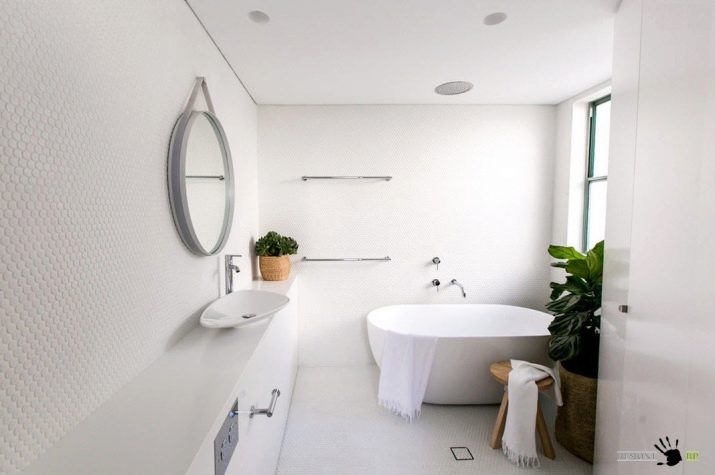




Peculiarities
It is worth making a reservation right away: the white bathroom is named so conditionally. The design does not imply filling the space with furnishing elements of white color alone. It only remains the dominant feature of the interior composition, but has a contrasting combination. The interior implies versatility. For this reason, several tones are used when designing furnishings.



White itself is unique. Few people know that it consists of all shades of the rainbow. This explains its compatibility with other shades of the color palette. Depending on this, he can take on different emotional colors. This factor is a distinctive feature of white and allows the use of tone in any detail of the chosen design.
It can be used:
- when facing walls, ceilings, floors;
- as the main tone of furniture and sanitary ware;
- for decorating accessories;



- in the design of bathroom lighting;
- in window frames, slopes, door frames, doors;
- in the tone of accessories, towels, bath linen.


The tone can be warm, cold, snow-white, the texture - coated, mother-of-pearl, matte, glossy. It depends on the type of material used to furnish the bathroom. This feature allows you to use products with different surfaces in the design, softening or highlighting a certain design accent. White brings together disparate pieces of furniture.
The choice of this color is especially good for small bathrooms. The design of a bathroom in a white tone is harmonious if the bathroom does not have natural light, which is gaining popularity today. This design is appropriate in the bathrooms of old apartment buildings such as Stalin, Khrushchev and Brezhnev.
With the help of white, you can get rid of the feeling of heaviness and the oppressive atmosphere created by the lack of usable space.



Advantages and disadvantages
To better understand the possibilities of bathroom design in white tones, it is worth considering the advantages of such a design:
- These bathrooms are aesthetically pleasing. Due to the variability of the shade texture, they can create a surface with the desired reflectivity.
- The dominance of white eliminates the need for hard wall slabs in the bathroom. Due to this, the walls can be visually made higher and wider.
- White color in the design of the bathroom allows you to visually hide the defects of the bases and the broken perspective, eliminating the visible fragmentation of the room.
- This tone can be the basis for any design style. White is appropriate in classic, ethnic, vintage, modern styles.
- White can be combined with lighting fixtures of any type and color. Due to him, they are appropriate in the interior, regardless of the decor.



- Add any color contrast to a white bathroom. It can be designed using products from materials of different composition.
- Depending on the perspective of a particular room, any corner can be favorably beaten due to the color. Color streamlines the interior, even on the shelves there will be no clutter feeling.
- White color contributes to the accuracy of users.Each family member will involuntarily begin to keep order when using such a bathroom.
- This design is variable in conveying the desired mood. Due to the shade, you can make the atmosphere special.
- Due to the development of new technologies, it is possible to perform a perfectly white coating without admixtures of other tones.



While there are many advantages, white bathroom design has drawbacks.
- White color of stamps. In the bathroom, it is constantly exposed to dirt, which is especially clearly visible on the snow-white surface.
- Despite the abundance of cleaning products, the white color in the interior over time loses its former attractiveness and becomes yellowish. This applies to furniture and accessories.
- The visual effect of white enhances not only the room. Furniture details also seem to be more voluminous.
- If white is placed on a background of white, it loses its expressiveness. For this reason, you have to add other shades to the design and mix the texture.
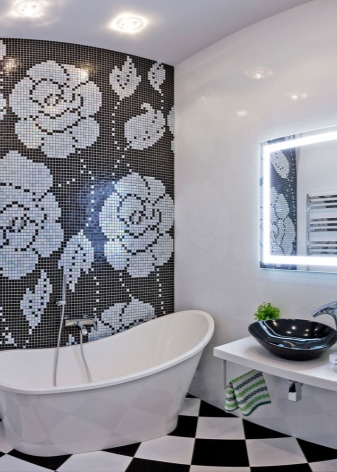

The abundance of white in the bathroom design obliges other rooms of the house to be decorated with a dominant white background. Otherwise, the stress on the eyes when entering the bathroom will be very strong. In addition, a sharp transition from one color perception to another can negatively affect the mood of the household.
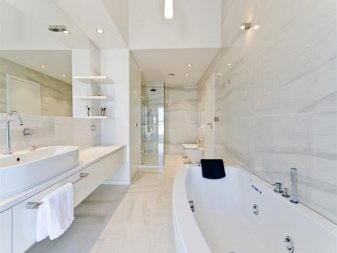

A color scheme
The choice of a complementary color to white should be deliberate. Even a small amount of contrasting shade can change perception. For example, to create the effect of a classic design with its inherent elegance, you can combine white with gold or bronze. These can be gold faucet handles with a spout, mirror frames, soap dish shades, lamp body, table handles, bath trim.
Gold will diversify even the most boring bathroom interior, make it softer.


Silver is more suitable for modern bathroom interiors. The presence of chrome surfaces looks less pretentious, although in this case, color contrast will have to be added to the white. For example, it can be a light gray color in the form of marble streaks, a combination of white, gray-white and green will be successful. In this case, the color can be supplemented with a small accessory (for example, a plant in a vase), an insert of a mosaic, a panel.
It is important that the color contrast is soft, muted.


Better than other tones, white in the bathroom is combined with shades of a natural (woody) scale. These are beige and brown tones of varying degrees of saturation. A popular combination of white with a shade of light and dark oak, wenge (diluted tone of brown and black).
Today, such a combination is more in demand than mixing white with beige and black, as well as bright accents.


With regard to the rich colors of the palette, it is worth noting: their combination is not always harmonious. For example, a red and white bathroom will give way in harmony to a design, based on which white will be combined with light wenge and green shades. Red is preferable to replace orange, yellow, pink. Violet-white, blue-white, turquoise-white or light green bathroom looks beautiful with the moderation of adding cold colors.
It is often better to replace bright colors with lighter ones (for example, a blue tint).


Combination of materials
In a bathroom, it is undesirable to use materials that are destroyed by moisture, steam, and household chemicals. The surfaces will have to be constantly cleaned, wiped, washed, dried. This means that the raw materials used for the elements of the arrangement must be resistant to destruction of any kind. Therefore, MDF, chipboard and similar slabs are not suitable for drawing up a bathroom interior.
The main types of materials for the bathroom are metal, wood, plastic, glass. Due to modern developments, materials based on different polymers can be added to the list.
For example, if earlier bathtubs were made mainly of cast iron, today it is more practical to use acrylic models with an attractive snow-white surface. It does not rust, does not change color during use, and lasts a long time.


The choice of a specific type of material depends on its purpose, shape, size. The convenience of the main part of the raw materials used for the arrangement is compatibility with each other. For example, wood looks good with marble. Glass is appropriate everywhere. It makes the space lighter, expands it, be it an ordinary partition, glass curtains or a mirrored sheet.
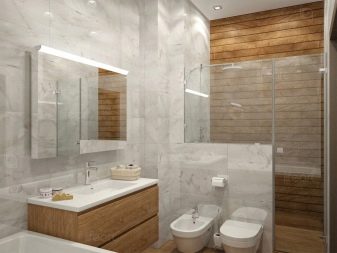

Countertops with sinks can be made of natural or artificial stone. They do not look massive, while they look good against the background of mirrors, marble surfaces, wooden boxes and metal structures with chrome or painted surfaces. Plastic is in harmony with any material. He is able to imitate the desired texture. This eliminates the need to use materials in the bathroom that deteriorate over time from water.


Selection of furniture
The number of pieces of furniture in a white bathroom is subject to the size of the room, the height of the ceiling, and the peculiarities of the layout. A prerequisite is the streamlining of the shape of any object. It doesn't matter if it is a shelving unit, a wardrobe, a table, a drawer unit or a set of open cantilever shelves. All edges must be processed to eliminate the possibility of injury.


If the bathroom is small, a standard set will fit in it: a sink with a cabinet and hanging shelves or a cabinet for hygiene items. When the bathroom is combined, it is usually possible to allocate more space for furniture. In this case, the shelves can sometimes be replaced with a compact linear or corner type shelving. If space is limited to a minimum, the room is equipped with a hinged shelf on the door. In such cases, you have to use any niche or beat the ledge.



It's another matter if the bathroom is spacious. The layout of such a room can provide a lot of possibilities for design in white tones. Some of these rooms are more like living rooms adapted for a bathroom. They can have a podium for a bath in the form of bowls of different shapes, two tables with sinks, a dressing table with a lot of roll-out drawers.
In addition, the set may include a rack with a heated towel rail, a chest of drawers with a mirror. Some rooms even have seating for relaxation.


Floor and walls
Different materials can be used to decorate the bathroom floor and walls in white tones. For walls, these are mainly tiles, mosaics, wall panels made of plastic of a rack or sheet type. The use of wallpaper, plaster is undesirable: they will damp and may come off the base. The best flooring materials are tile, porcelain stoneware and epoxy flooring.
Since white is completely impractical for the floor, it is diluted with light gray, a shade of light wenge oak and a gray-beige tone. You can try a combination of white with neutral marble.
The material for the floor covering must be selected with anti-skid properties in order to eliminate the risk of injury. A small relief or matte type of texture will do. Better to use stone or granite.


For wall decoration, it is better to use plastic panels with an imitation of the desired texture. It can be a type of aged painted wood, imitation of a mosaic, brick or tiled masonry. For the bath area itself, tiles will be the best cladding material. It is durable, practical, easy to clean, and abrasion resistant. At the same time, it can be combined with panels and include small panels in the design, which diversifies the interior of the room.


The choice of plumbing
When choosing a bath, it is worth considering a number of requirements. In addition to the features of the layout and footage, today it is possible to take care of additional comfort, taking into account the interests of each household. For some, the usual option in the form of an oval bath is enough.
In confined spaces, it is possible to use the corner version. Some people prefer a shower cabin. Others like bowl baths or jacuzzis. In addition to the shape, the bathtub may differ in the presence of handrails, steps, and seating devices.
There are many options on the market. If desired, each customer can choose the model they like, taking into account the taste and budget.
If there is no such product, you can order a bath individually, the choice is really wide. When you want originality, the bath is decorated with imitation brickwork with gray seams.



Some people prefer the version with legs. Someone prefers round and even triangular models. When a large room is allocated for the bathroom, a bathtub for two can be installed in it. Each type of product has its own decor. For example, the back of the bathtub can be decorated with an imitation of stucco molding from the base material.

If the bathroom is combined, they try to match the toilet to the main plumbing. In this case, it is necessary to choose not only the whiteness of the shade. It is important to repeat the texture of the bath material. The same goes for the shell material. Otherwise, you will not be able to create an ensemble effect.
This problem can be partially solved by purchasing identical valves, faucets with spouts. This will distract attention from minor discrepancies in texture or shape. If the shade is different, you will have to separate the plumbing from each other with a contrasting shade of furniture, countertops, wall or floor coverings, and make a niche in a different tone. This will make the difference less pronounced.


Lighting
The bathroom lighting system implies a composition of central and auxiliary lighting. This is a division into 2 (sometimes 3) functional areas. This approach is due to the stringent requirements for bathroom luminaires.
The standards include:
- distance from hazardous (wet) areas;
- the minimum allowable height value;
- type of luminaire protection;
- resistance of the light source to moisture;
- installation technology.


The central lighting of such a bath is a surface panel, spotlights of built-in type, as well as flexible LED strip or cord, less often - models with reflectors. Since such devices shine in a directional way, individual corners of the bathrooms are not lit in the required volume. Therefore, it is necessary to additionally highlight the area above the mirror. Different lighting techniques are used here. These can be lamps with tilt angle adjustment, geometric models, built-in light inside mirrors.



The shape of the lamps is preferable to be ergonomic. Massive design gives way to light solutions. In the center of attention are several laconic lamps that create the effect of harmony of lighting design.
The decor of devices can be gilding, forging elements, chrome, openwork motifs. If possible, the devices should be closed, with white fog lamps in priority. It is better to choose a light shade neutral or warm white.


Interesting ideas
Reviews left on the forums for the construction and renovation of bathrooms indicate that a bathroom in white is the current trend of our time.
This is confirmed by examples of the photo gallery:
- Stylish modern solution with the use of a niche and a minimum set of details for the arrangement in the bath and sink area.
- A room in the spirit of a living space. Glass curtains separate the shower area and the place for the dressing table and chair.

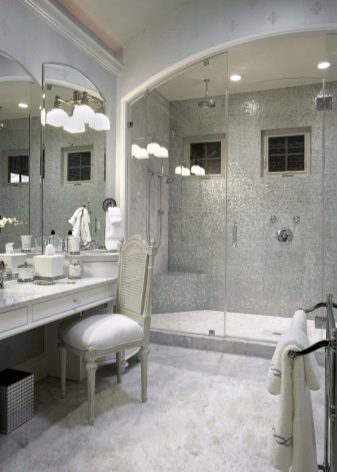
- An example of using panels for brickwork, a combination of white gloss with a matte light brown contrast.
- Option with an arched window and a niche used for built-in furniture with a mirror, drawers and shelving.


- An example of changing a neutral interior by adding accessories in a blue tint.
- An original solution for decorating a small space. Mixing white with woody and green brings cheerful colors to the design.


- Dilution of white and gray gold. The use of glossy surfaces, a combination of curved and straight lines.
- An example of creating a single ensemble of sanitary ware and furniture through the use of gilded decor. In addition to the basic set of elements, a mirror frame, towel holders and baguettes are involved.


- The option with a shower cabin is successful due to the mosaic type tiles with mother-of-pearl. The combination of different patterns of wall decoration looks interesting.
- An example of changing color perception due to RGB LED backlighting. The light from the built-in tape makes the wall surfaces appear blue.


- The combination with blue looks beautiful and fresh. The use of a glossy texture makes white the dominant color in the design.
- The inclusion of a green mosaic strip around the perimeter of the room changes the perception. The bathroom looks cozy.


For information on how to choose a tile for a bathroom, see the next video.













The comment was sent successfully.